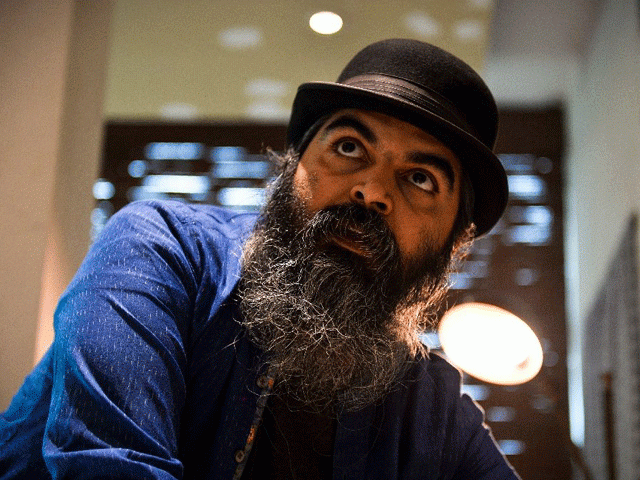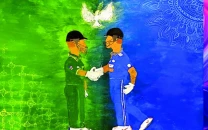India's prize-winning designer steadies for world stage
The 37-year-old faces challenges unique to India

He shot onto the world stage after winning a glittering international fashion prize previously given to design icons Yves Saint Laurent and Karl Lagerfeld.
Yet India's Suket Dhir -- hailed by Vogue as a potential "global fashion superstar in the making" -- is uneasy about the sudden attention that has come with winning the International Woolmark Prize for menswear this year.
"I never thought of myself as a top designer, more of a glorified tailor," Dhir told AFP at his small, busy design studio in the backblocks of New Delhi.
Red carpet round-up: A night at the Emmys
Dhir is now in a race against time to deliver his award-winning collection to prominent department stores in New York, Paris, Tokyo, Seoul and Sydney from next month -- as well as around $75,000 in prizemoney to build up his business, he also gets to provide a capsule collection for key retailers worldwide.
The 37-year-old faces challenges unique to India in preparing the collection of contemporary Western menswear with an Indian twist.
 PHOTO: AFP
PHOTO: AFPDhir uses traditional weavers located close to the villages that they come from, along with dyers and block printers from all over the vast country to make his clothes.
But the artisans are not used to working with the wool that is required for the collection and which can change shape in India's blistering heat and humid monsoons.
"This was my first experience weaving with such difficult fabric on such a tight deadline. These designs were one-off pieces and (now) I'm reproducing this collection for five or six stores," he said.
"We've successfully managed to do that (although) we are a little behind schedule."
On the fashion front: Let’s hear it for New York!
The judges of the prize, awarded in January, noted Dhir's attention to detail in his collection of tailored jackets, shirts and loose pants which were inspired by his childhood spent with his grandfather in Punjab state.
The linings of his jackets are block-printed with small motifs such as umbrellas, and the buttons on his shirts are sewn on with different types of thread.
 PHOTO: AFP
PHOTO: AFPDhir said his clothes, some of which are mixed with silk and use the traditional ikat technique -- hand-tied and dyed yarn -- to pattern textiles, are meant to be worn every day.
Don't do bling
"When I think of my grandfather, I think of these beautiful jackets and blazers that you could pass on from one generation to the next," the father-of-one said.
"I can't do anything blingy," he added.
Indian menswear often involves garish outfits such as heavily embroidered jackets and bright silk kurtas or long shirts.
Leading fashion journalist and author Shefalee Vasudev hailed Dhir as one of an increasing number of Indian designers making subtle, contemporary clothes.
"His fashion is meaningful. It's not screaming for attention. It's not saying 'look at me, I'm so great' and that's refreshing in Indian fashion," said Vasudev.
 PHOTO: AFP
PHOTO: AFPShe said the coming months would be critical for Dhir -- and will determine whether he can become one of only a small number of Indians sought after in international stores.
"More than a handful are stocked but only a handful have been noticed and get consistent business," she said of Indian designers.
"It's a very significant prize because the door has been knocked down for you. (But) You need to be able to manage your quality, your numbers, your deliveries," Vasudev added.
Vin Diesel wearing a Sherwani is too cute to be ignored
She pointed to the international success of Indian designer Rahul Mishra, who won the same prize for womenswear in 2014, as an example of what was possible.
On the road to becoming a recognised designer, Dhir worked in a call centre and sold mobile phones and also spent several unsuccessful years in college, infuriating his family.
"I was clueless about what to do with my life," he said.
He then enrolled at the National Institute of Fashion Technology in Delhi before starting his own label in 2010.
Dhir said the first few years were rocky financially, largely because he refused to design outfits to cater for India's lavish annual wedding season, which many designers rely upon for income.
"I don't do wedding gear and that's where the money is. But this acknowledgement, this recognition (of winning the award) has happened because I have stuck to my aesthetic," said Dhir, the first Indian to win the award for menswear.
"We are breaking even at the moment which is really good. I wish I had a swankier office and a swankier car but we'll get there."
Have something to add to the story? Share it in the comments below.



















COMMENTS
Comments are moderated and generally will be posted if they are on-topic and not abusive.
For more information, please see our Comments FAQ